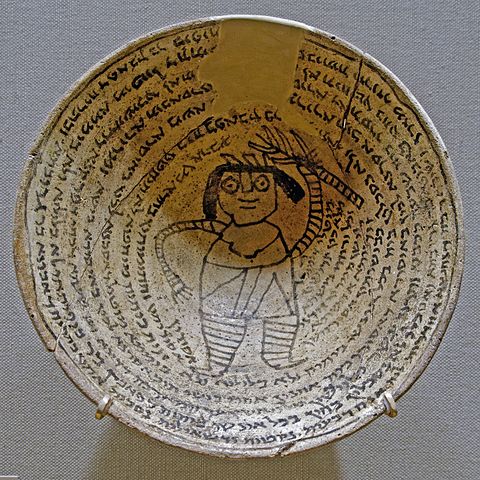Difference between revisions of "Template:POTD protected"
Occultwiki (talk | contribs) |
Occultwiki (talk | contribs) |
||
| (83 intermediate revisions by the same user not shown) | |||
| Line 1: | Line 1: | ||
{| role="presentation" style="margin:0 3px 3px; width:100%; text-align:left; background-color:transparent; border-collapse: collapse; " | {| role="presentation" style="margin:0 3px 3px; width:100%; text-align:left; background-color:transparent; border-collapse: collapse; " | ||
|style="padding:0 0.9em 0 0;" | [[File: | |style="padding:0 0.9em 0 0;" | [[File:Incantation bowl Lilith.jpg|300px|thumb|]] | ||
|style="padding:0 6px 0 0"| | |style="padding:0 6px 0 0"| | ||
'''[[ | An individual '''[[Lilith]]''', along with Bagdana "king of the lilits", is one of the demons to feature prominently in protective spells in the eighty surviving Jewish [[occult]] incantation bowls from Sassanid Empire Babylon (4th–6th century AD) with influence from Iranian culture. These bowls were buried upside down below the structure of the house or on the land of the house, in order to trap the [[demon]]. Almost every house was found to have such protective bowls against demons. | ||
<p><small> | <p><small>Photo credit: The Metropolitan Museum</small></p> | ||
[[:Category:Images|'''(More Images)''']] | [[:Category:Images|'''(More Images)''']] | ||
<div class="potd-recent" style="text-align:right;"> | <div class="potd-recent" style="text-align:right;"> | ||
Latest revision as of 17:49, 29 November 2025
|
An individual Lilith, along with Bagdana "king of the lilits", is one of the demons to feature prominently in protective spells in the eighty surviving Jewish occult incantation bowls from Sassanid Empire Babylon (4th–6th century AD) with influence from Iranian culture. These bowls were buried upside down below the structure of the house or on the land of the house, in order to trap the demon. Almost every house was found to have such protective bowls against demons.
Photo credit: The Metropolitan Museum |
